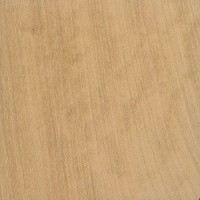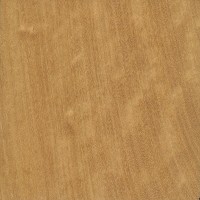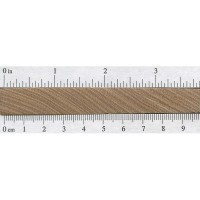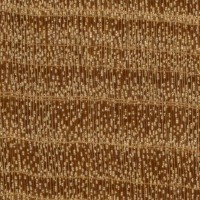 |
Common Name(s): West Indian Satinwood Scientific Name: Zanthoxylum flavum (syn. Fagara flava) Distribution: Caribbean Tree Size: 30-40 ft (9-12 m) tall, 1-1.5 ft (30-46 cm) trunk diameter Average Dried Weight: 56 lbs/ft3 (900 kg/m3) Specific Gravity (Basic, 12% MC): .71, .90 Janka Hardness: 1,820 lbf (8,100 N) Modulus of Rupture: No data available Elastic Modulus: No data available Crushing Strength: No data available Shrinkage: Radial: ~6%, Tangential: ~9%, Volumetric: ~15%, T/R Ratio: ~1.5 |
Color/Appearance: Heartwood ranges from light to golden yellow, to orangish brown. Whitish yellow sapwood generally paler than heartwood, but not always clearly demarcated from heartwood. (Color tends to darken with age upon exposure to light.) Frequently seen with a mottled or rippled grain pattern, resembling ripples in satin fabric, lending to its name satinwood.
Grain/Texture: Grain is interlocked, producing an attractive mottle figure, as well as striped or roey patterns on quartersawn surfaces. Texture is fine and even, with a very high natural luster.
Endgrain: Diffuse-porous; medium pores in no specific arrangement, moderately numerous to numerous; solitary and primarily radial multiples of 2-6; heartwood deposits occasionally present; growth rings distinct; narrow rays not visible without lens, spacing normal; parenchyma marginal.
Rot Resistance: Reports range from durable to non-durable regarding decay resistance, with intermediate resistance to insect attack.
Workability: Difficult to work on account of its high density and interlocked grain. Most surfacing and planing operations result in tearout, especially on quartersawn surfaces. Pronounced blunting effect on cutters. Turns superbly. Glues and finishes well—able to take a high natural polish.
Odor: Has a faint, coconut-like scent when being worked.
Allergies/Toxicity: Although severe reactions are quite uncommon, West Indian Satinwood has been reported as a sensitizer. Most common reactions include skin irritation, as well as other effects, such as rash, blisters, and diarrhea. See the articles Wood Allergies and Toxicity and Wood Dust Safety for more information.
Pricing/Availability: Sustainable supplies of this species have been exhausted for over one hundred years; for all intents and purposes, this wood is commercially unavailable. Most genuine satinwood offered for sale today is the East Indian variety, or a substitute.
Sustainability: This wood species is not listed in the CITES Appendices, but is on the IUCN Red List. It is listed as vulnerable due to a population reduction of over 20% in the past three generations, caused by a decline in its natural range, and exploitation.
Common Uses: Veneer, inlays, fine furniture, turned objects, and other small specialty items.
Comments: West Indian Satinwood also goes by the names Jamaican Satinwood, San Domingo Satinwood, or Yellow Sanders. This tree is one of only two species that have been recognized historically as satinwood, with East Indian satinwood (Chloroxylon swietenia) being the other. Record and Hess comment: “Antique Satinwood furniture is almost exclusively of this species [Z. flava], but in later times Ceylon or East Indian Satinwood (Chloroxylon Swietenia DC.) came into general use.”[1]Record, S. J., & Hess, R. W. (1949). Timbers of the new world, p. 482. However, it should be noted that this comment was published back in 1946, so the author’s definition of “antique satinwood furniture” may be much narrower (i.e., older) than what we would consider today.
None available.
Scans/Pictures: A special thanks to Steve Earis for providing the wood sample and turned photo of this wood species.
References
| ↑1 | Record, S. J., & Hess, R. W. (1949). Timbers of the new world, p. 482. |
|---|







